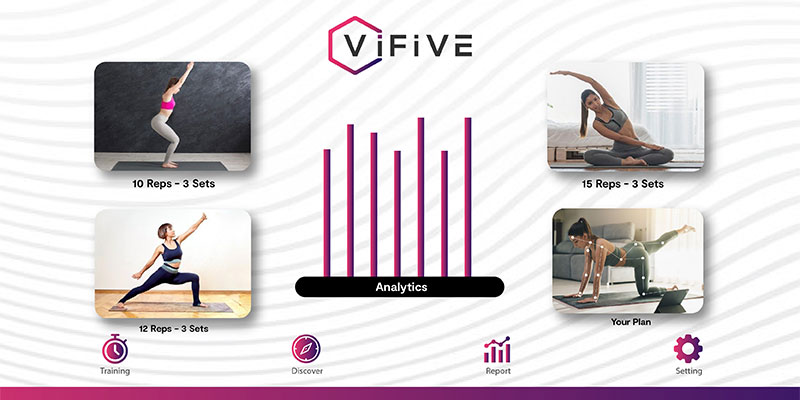Wearables have been at the forefront of remote monitoring for nearly a decade, but now computer vision is poised to offer all of the same benefits without any of the drawbacks that have persisted in sensor-dependent technology.
The need for effective MSK care is huge
The healthcare market is growing with no signs of stopping: before the COVID-19 pandemic, the Center for Medicare and Medicaid Services Office of the Actuary released a report estimating that annual spend on healthcare would grow to nearly $6.2 trillion by 2028. Even with slowed spending during the pandemic, Deloitte estimates US healthcare spending will reach $8.2 trillion by 2040. As a result, much of the discussions in the healthcare market focus on reducing costs and spending, particularly by promoting technology that facilitates early detection and prevention of chronic conditions.
The CDC reports 60% of adults in the US have at least one chronic condition. Chronic conditions are defined as conditions lasting 1 year or more that require ongoing medical attention or prevent daily tasks or both. Chronic conditions are widespread in the US and very costly— the CDC estimates 90% of the $4.1 trillion spent annually on healthcare is for patients living with chronic conditions . Employers are focusing on musculoskeletal (MSK) care to address the pervasive issue of chronic conditions. A 2021 survey of large US employers found 68% predict they will implement virtual MSK care by 2023 (compared to today’s 19%). Virtual MSK care management is expected to grow more than any other virtual care service.
Sensors are barriers to patient and provider adoption
Remote Patient Monitoring (RPM) systems have gained attention recently as an effective virtual health care management tool. Medicare’s Chronic Care Management program’s gross savings were $88 million over a 12-month period, generating net savings of $36 million. The University of Pittsburgh Medical Center’s RPM system reduced the risk of hospital readmissions by 76% and a KLAS survey of 25 healthcare organizations running RPM programs focused on chronic care management cited cost reductions as a result. Insider Intelligence estimates that global RPM systems will be worth $1.7 billion by 2027, and as many as 30 million US patients could use RPM systems by 2024. However, studies suggest that RPMs may be difficult to implement as patients reported concerns regarding costs of sensors, tablets, and other devices that are often used in remote patient monitoring .
Patient’s concerns over the cost of sensors may seem surprising when confronted with the rapidly growing wearable technology market. US consumer use of wearable sensors (colloquially known as wearables) increased from 9% to 33% in just four years with no sign of slowing down. The widespread availability of wearable technology have made them particularly attractive to monitor and encourage preventative care. John Hancock, one of the largest life insurance companies in the US, made headlines in 2018 by expanding their wearable reimbursement program across all policies and in 2021 offered new Apple Watches to members for $25. Interestingly, only a handful of other insurance providers have followed this model in the following years; in fact, a survey of insurance experts found that insurance providers are still hesitant to adopt wearable technologies due to inaccurate measurements and application errors by patients .
These concerns are not unfounded, as various studies have found functionality and affordability to be significant barriers to patients using wearables . Patients, particularly older patients, struggle with using wearables correctly which results in inaccurate measurements and low compliance. As a result, older patients are much more likely to drop off using wearables and generally drop out of monitoring programs at a higher rate. And while some studies have shown that when wearables are used correctly the results are accurate and reliable, this outcome requires significant effort on behalf of researchers and clinicians to successfully train staff and patients on how to correctly use the wearable device. The likelihood of finding time and resources in an already strained healthcare system is limited, and thus many efforts to use wearables have found them to be unreliable in practice.
With the addition of Remote Therapeutic Monitoring (RTM) to the 2022 CMS physician fee schedule, there’s been a surge of awareness in MSK care management. RTM further implements RPM’s benefits for MSK domain by specifically addressing needs for monitoring a patient’s musculoskeletal status as well as adherence and other key indicators. However, even with the widespread availability of wearable technology, wearables are still expensive for patients with RTM codes. The cost of 2 wearable sensors, a tablet, and an average home exercise plan subscription is $800✝. It’s understandable that patients would not accept such a cost as a part of their health plan.
Computer visions cuts costs while delivering accuracy
Computer vision has made many changes and progress in its accuracy. In particular, computer vision programs powered by artificial intelligence have bridged the gap between accuracy of wearable sensors and computer vision . This means that researchers and clinicians no longer have to make the trade-off between a low cost, low effort technology and one that is more accurate and reliable. Computer vision allows patients to effortlessly work through their programs without a cost and without the barrier of a sensor.
Computer vision has even advanced beyond the need for advanced computational power or high resolution cameras. Programs like simplePose and Google’s blazePose can provide real-time body tracking using just a smartphone’s or tablet’s camera with accurate results. Smartphones are becoming increasingly popular among the general population, with 92% of cell phone users owning a smartphone.
Computer vision technology is not only far more scalable than wearable sensor technology, but also more reliable in its accuracy. Computer vision is also much more appealing to patients without the physical or financial barriers of sensors. Computer vision has already proven to be a low-cost, low-effort tool for MSK care management, and the best is yet to come.
Want to see the applications of computer vision in MSK care? Learn more about ViFiVE’s remote physical therapy platform here. Contact us to learn more about how computer vision can change your business.
✝Based on an average of products and services that were widely available in 2022.


